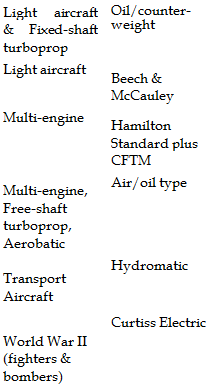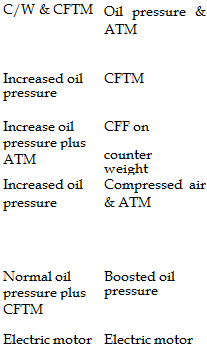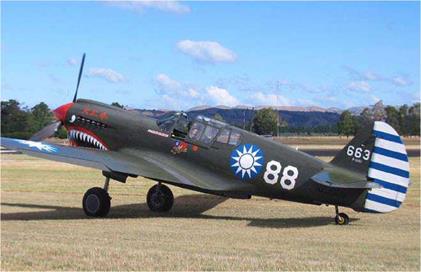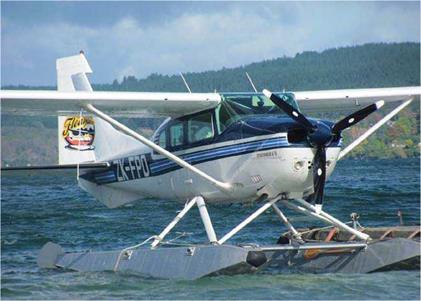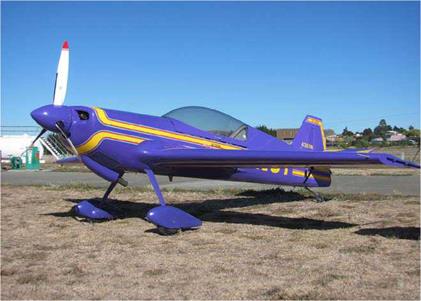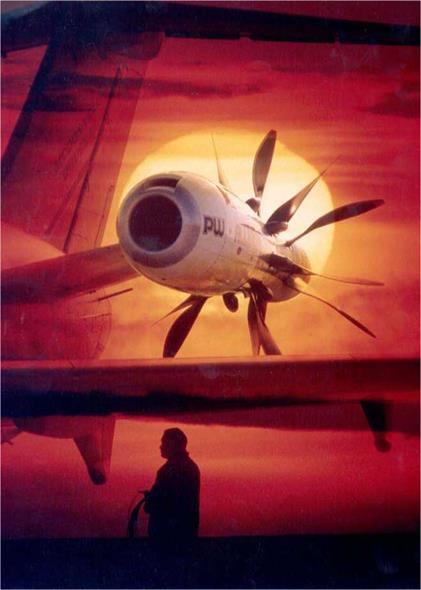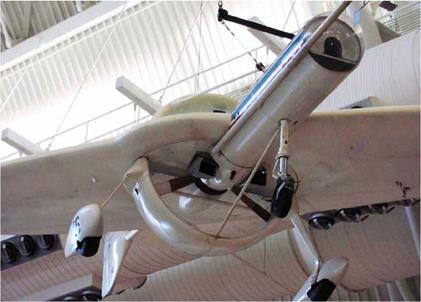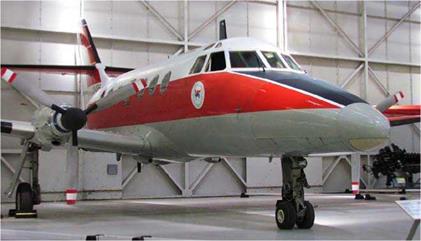Material stress can be divided into four main categories of torsional, tensile, compression, and bending stress. Any one stress or combinations of stress can be present acting on an aircraft or propeller at any one time. Stress is measured as a force per unit area. The stress will vary depending on the operating conditions of the propeller, the stress force can be reversed if the propeller is windmilling or with reverse thrust application. Life for a propeller is not an easy one!
Reference to Diagram 19, Blade Stress Forces, shows the centrifugal force caused by the spinning propeller acting from the propeller hub through the leading and trailing edges of the propeller blade. The centrifugal force is divided into two components, one causing tension (tensile stress) due
to stretching and the other component causing a centrifugal turning moment (torsional stress).
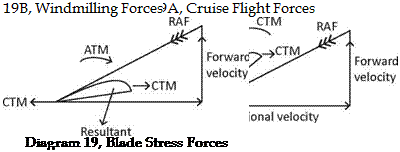
The tensile stress tends to flow through the propeller blades outwards, in effect stretching the blade in length and generating a considerable force on the propeller hub and increases towards the propeller tip .
The centrifugal turning moment (torsional stress) acting at 90 degrees to the propeller axis produces a turning moment around the propeller pitch change axis tending to turn the blades towards fine/flat pitch. This force is opposed by the pitch change mechanism, which is placed under stress, but is assisted to a certain degree by the aerodynamic turning
moment during normal cruise conditions, which tend to turn the blades towards coarse pitch. The pitch change axis is normally to the rear of the blade’s centre of pressure. The resultant aerodynamic force acting at the centre of pressure will tend to turn the propeller blades in the opposite direction; the direction is reversed when the propeller is windmilling causing the resultant force to act rearwards. The aerodynamic turning moment is acting in the same direction as the centrifugal turning moment and turns the blades towards fine/flat pitch. The centrifugal turning moment is a more powerful force than the aerodynamic turning moment and causes the most stress. Torsional stress forces increase with the RPM squared.
Additional to the stress mentioned above, is the bending stress on the blades caused by the thrust (blade loading) of the propeller. The blade loading is measured in horsepower per square foot. The force generated by the propeller tends to bend the blades forward when under power, while the tension in the blade caused by the centrifugal force opposes the thrust, which tends to straighten the blades out. Bending stress will be reversed in direction with reverse thrust application on the landing rollout.
At normal cruise RPM, the stress on the prop blades will be approximately 4500 pounds per square inch. On some engine/ prop combinations, a destructive vibratory frequency could exist at around 1900-2200 RPM. This torsional vibration can increase stress on the prop tips to that double experienced at normal cruise RPM. This is due to varying aerodynamic loads acting on the prop caused by a high vibration frequency coupled with the high inherent vibrations of the engine cylinder firing pulsations. If the vibration from the propeller coincides with those caused by the engine, a severe vibration will result. This is a different vibration to that caused by an out of balance prop and the pilot is unlikely to notice it. When the propeller’s and engine’s vibration synchronizes the amplitude of vibration can rapidly increase causing severe stress with possible blade failure or hub damage with disastrous results. A caution arc on the engine tachometer covers the RPM range to be avoided for continuous operation. This problem is only peculiar to certain aircraft: those aircraft with composite props are less prone to this vibration, while turboprops are totally free due to their lack if cylinder vibration. The red line at the top end of the tachometer scale indicates the maximum RPM permissible and exceeding the redline limit, apart from engine operating limitations, would allow the prop tips to reach the speed of sound. Additional stress would then be caused due to vibration flutter caused by the high propeller tip speed. Although safety margins are built in, red line limits should never be exceeded intentionally at any time.
Another form of stress can be induced by stone or gravel ingestion through the prop disc, and striking the blade’s leading edge. This will cause damage in the form of knicks, or stress raisers, which can lead to stress concentrations. The blades flexing under normal loads, especially in the area from 12.5 cm to 23 cm (5 to 9 inches) from the tips can lead to metal fatigue and loss of the prop tip. The result will be extreme vibrations caused by the prop being out of balance and could lead to the engine being torn from its mounts. With the engine heading earthwards and the aircraft’s centre of gravity moved well aft, it would be very difficult to achieve a balanced glide, the end result can easily be imagined! If the engine is still onboard, but shaking badly, it is imperative the engine is shut down and the prop feathered if possible. If the propeller is not the feathering type, reduce air speed as low as possible until the engine stops. Prevention is the best cure; any knicks found on the prop should be filed, or dressed out to prevent a crack from forming. Avoid taxiing over loose gravel if possible, but if it is unavoidable reduce power to a low RPM. Never runup an engine over loose gravel and when taking-off, open the throttle slowly to get the aircraft moving before going to full
|

|
The 1917, WW I, Bristol Bulldog IIA has prop tipping on the prop’s leading edges. It is displayed in the RAF Hendon Museum, London.
power. This technique will allow the prop to blow the gravel well clear without causing any damage to the prop blades. Tail – wheel aircraft have a greater clearance between the prop tips and the ground and are therefore less prone to stone damage than their trike counterparts.
Sharp taxi turns can induce stress on the prop because the prop acts in the same way as a gyroscope due to its spinning mass and will attempt to resist any changes in direction. All power changes should be made smoothly and gently to avoid any undue stress being applied to the engine or the prop attachment bolts On a wooden prop, check the metal sheathing, (also known as prop tipping) on the leading edge of
|

The wooden prop blades on this Handley-Page Halifax II bomber were sheared off during its war time crash-landing. The Halifax is displayed as recovered in the RAF Hendon Museum, London.
|
each blade is secure and free of any damage. Also, there should be no splits or cracks in the wood or separation between the wood laminations. A wood prop not used for long periods should be parked in the horizontal position to equalize the moisture content in each blade.
The ultimate stress force a prop can endure occurs when the prop blades strike the ground during a crash or wheels-up landing. Metal blades will bend either backwards or forwards during the impact. The resulting force, which in turn depends on a number of factors determine which way they bend. These factors include the blade chord, shape, and pitch, and the aircraft’s forward speed at the time of impact and also if the engine is providing power to the prop, or just idling. If the aircraft slide sideways the blades will buckle as well as bend. This kind of treatment is to be avoided to say the least! Wooden props and their engines can generally fare better in a crash landing. The wooden prop is more likely to break up than a metal prop and absorb some of the impact stress, protecting the engine somewhat. If you have the misfortune to forget to lower the undercarriage on the approach, you may hear the prop making ground contact as you flare for the landing. Do not attempt a go-around at this late stage in the hope of landing wheels-down on the next attempt. The damage is now done to the prop and the inherent forces associated with a full power climb could lead to total prop destruction and loss of the aircraft. It is safer to carry on with the landing and ride out the ensuing belly-ride. It must now be obvious the prop is a very important part of the aircraft and deserves to be treated gently with the utmost respect.
